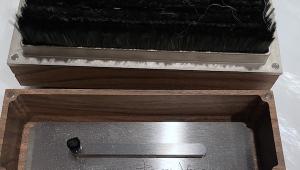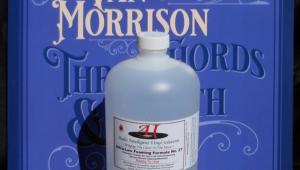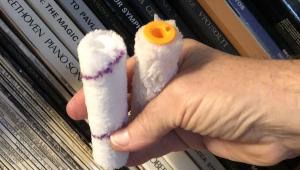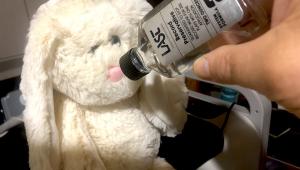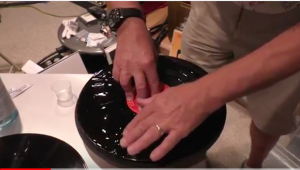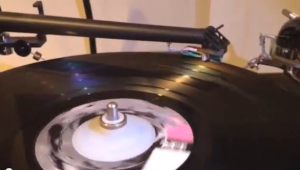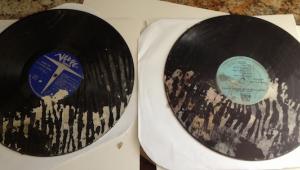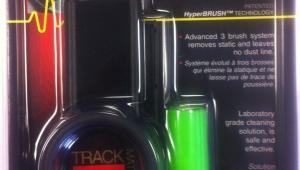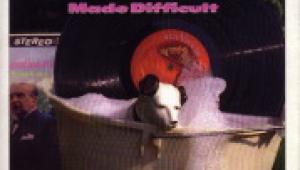Think of how few people in the entire world are as anal as you are about record and stylus care. When you've cleaned every LP before playing and are religious about keeping your stylus clean, it appears that, under a microscope, feces will occur regardless.
Don't Let This Happen to You!
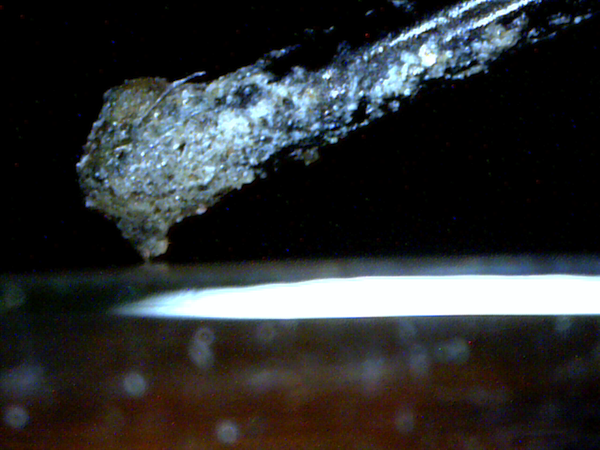
Now I play either new or cleaned records and I do clean that stylus. I swear! With the naked eye it appeared clean but clearly it is not, even though the stylus tip appears to be.
So take whatever magnifier you have and take a look! Try to keep the cantilever and the entire stylus assembly as clean as possible being careful not to get fluids into the cartridge body and be gentle about it!
But if you aren't careful you could end up with this kind of mess. And I thought I was being careful. I'm going to redouble my efforts.
Now it's time for your mocking comments. It's okay. I'm ready, willing and deserving!
- Log in or register to post comments


I'm not going to mock you. But I would surely love to read about how you solve this problem and see pictures of the results.
- Kam

This is actually quite well timed. I'm a vinyl newb and recently asked my dealer about using the Last stylus cleaner you recommend. His reply was that they don't recommend using any liquid cleaner at all and to only use the little plastic wand thing that comes with the Ortofon cartridge (2M Black). So what is the best way of cleaning the stylus and avoiding the problem you now have? Do liquid cleaners really damage the stylus as my dealer claims?

Personally, I've not heard of liquid cleaners damaging a stylus. I use MFSL #9. Though lots of people are big fans of Zero Dust. It's a jello like cleaner which you dip your stylus into and pull it back out, leaving all the dust inside. If you're hesitant about liquid cleaners it's probably the best way to go.

How did you clean the Atlas?

Michael,
What is the level of magnification in that photo?

That had to be an anomaly with your rituals, right?
I have used Last stylus cleaner and stylast for over 20 years and swear by it. I believe you use a different stylus cleaner Mike? I know you use LAST record preserative on your records if memory serves. I also swear by that.
My inspections prove to me that my money is well spent buying LAST products.
I am waiting to find out what happened and why?

Time to replace the brushes on the Audio Desk?

...me of a creepy sci-fi movie I saw when I was a kid!
It also raised a related question for me: With all the new vinyl I've been getting lately, I decided to not play any of it until I had Nitty Gritty'd it with NG First then NG Pure 2 (used LPs with NG PureEnzyme then Pure 2). As a result I'm falling way behind in my listening since cleaning LPs does take time. Does everyone else clean new vinyl before playing it? I'm curious, thanks.

Yup, I clean every record with Audio Intelligent Enzyme treatment, then super cleaner, then triple distilled water rinse. On a VPI 17. Works very well.
All new records also get this treatment. Older records often get a pre-wash of a locally made record cleaning fluid to get the worst of the gunk off. You buy a 30 or 40 year old record, it will have 30 or 40 years of dust and particles in the grooves. Stands to reason. Older, dirtier records get the worst of the gunk sucked out on the first round, the enzyme loosens things up, then the super cleaner takes care of the rest. Then the triple distilled water to flush out the residue. Using four different dedicated brushes of course, I use cosmetic cotton pads as described in that fanatics guide to record cleaning available on this site.

...of those cleaners is meant to remove the "mold release compound" from new vinyl? In my scheme, the NG First is supposed to do that. I do use a dedicated hand-held brush for it but since with the NG 1.5 you generally put the fluids on the felt "lips" themselves, both the NG PurEnzyme & Pure 2 go on them, in sequence, with rotating scrubbing in between (for used records, that is).
Do you manage to keep up with your cleaning?

that removes the mold release compound. It's good to leave it soak for a minute or so to loosen it. It seems to work very well.
The way I do it is use cotton cosmetic pads clipped to a nail brush with all the bristles removed except for the center row. That way it's easy to change out the pads when they get dirty.
I tend to wait till I've got five or ten records, or more, then pull out the cleaner and spend a couple of hours or however long it takes...

I use one of those vibrating pad cleaners. I hope it keeps my needle tip clean but without access to a microscope you can never be sure?
It would be interesting to hear how your one sounds after you have cleaned it?

If that's one of those high frequency vibrating pads where you can hear it humming, I suggest you stop using it immediately. I used to use a Maxell vibrating platform to clean my stylus but it ended up ruining the coils in a very expensive cartridge.

If that's one of those high frequency vibrating pads where you can hear it humming, I suggest you stop using it immediately. I used to use a Maxell vibrating platform to clean my stylus but it ended up ruining the coils in a very expensive cartridge.

Well I have been using mine for over 20 years and haven't damaged any coils yet...?

I have read somewhere that a cut of little piece of Mr Clean Magic Eraser works pefectly to remove dust. Also there are some cartridge manufacturer don't recommend to use any liquid stilus cleaner. I have seen on your DVD that you are wery well equipped with solutions, cleaners and brushes, but what is your opinion about the custom made tricks?

HI Michael,
Could you share a few details, specifically:
- Have all of the records you have been playing been washed in the Audio Desk cleaner? If yes, any changes folks should make to their cleaning regiment?
- Do you use the SPT cleaner on the Atlas? Would that have made any difference?
Would REALLY love to learn how you clean it, and what the end result looks like.
keep spinning!

To add to my question. My Atlas got horribly gunked up (under the digital microscope it looked much like Mike's) when the cleaning brushes on the Audio Desk were at the end of their recommended 500 record lifespan. I was starting to see a stray white fiber on an otherwise Audio Desk cleaned record. When I checked the Atlas under the microscope it was disaster like Mike's. Took a lot of work with the Lyra fluid and the brush to get it cleaned. Replacing the brushes in the Audio Desk cleaner solved the problem going forward. Otto

I have just decided that the best you can hope for in a world like today is something in between "pretty good" and "i never really noticed" when it comes to some things. I have yet to wreck an lp with any stylus but I guess I really may never know.

I've was warned decades ago about liquid stylus cleaners and the damage they do and stopped using them. I've been using a putty that used by watch makers for the last 15 years to clean my stylus and it does a great job.
Looking at Analog Corner #36, it looks like you use liquid cleaners on your stylus.
Stylus cleaning fluids
I'm staring at four bottles of stylus cleaning fluid: Record Research Lab's "LP #9" (a takeoff on the old Lieber/Stoller Coasters' song "Love Potion #9"), distributed by Musical Surroundings; LAST "Stylus Cleaner"; ClearAudio "Diamond Cleaner (The Elixir of Sound)"; and Immedia's "Needle Nectar." Which one(s) do I recommend? If I wanted to do some serious, well-lubricated self-stroking, I'd talk about how each imparts a different and quite particular tonality to the music. I'd guide you toward a particular brand in an effort to impose my leadership upon you with a certainty designed to enhance my position and cauterize your audiophile neurosis.


Sumiko specifically recommends using Last Stylus Cleaner in the manual that came with my Blue Point Special.

I think I see Steve McQueen in there.


This is the info' Ortofon has on their website regarding stylus care:
“The use of solvents on the stylus and cantilever may damage stylus cement; interior parts of the cartridge can be affected seriously by the intrusion of solvents. The Ortofon warranty service will not be valid in cases where such treatment has caused malfunction of your cartridge.
For cleaning the stylus, use carbon fibre brush a few times along the cantilever in the direction of the stylus, whenever you play a new record or change sides. This will take all normal dust and most of the slick release agent from new records. Remove dust from the stylus tip using a suitable small brush, such as one of the Ortofon types with the packing, which should be guided carefully along the cantilever in the direction of the stylus tip. Following this treatment there will normally be no need for further stylus cleaning.
Please remember to remove dust from the diamond tip before and after playback of each record."

Michael: Peter Lieberman of Soundsmith recommends using Fun Tack which is the US-Loctite equivilent of Blu-Tack. Since changing to this product, my stylus's (3 turntables) have stayed consistently clean where I couldn't keep them clean with an other product.
Might be worth a try. I made some wood posts that are appoximately the height of the arm at rest and stuck the Fun Tack on top. Seems to work really well.
Peter Truce

Michael. Swipe the entire underside of your cart with a carbon fiber brush after each side (occasionally brushing the top of the cantilever) and follow with two dips into an Onzow Zero Dust. Done.
I clean the entire cantilever with LAST Stylus Cleaner every couple of weeks, in all directions. Nothing will break. Paranoia is for audiophiles. Love ya, but man...

...of the training films I used to show to scare sailors and Marines.
Doc

So, pinching off the dust ball when it grows large enough to grab isn't enough? Next you're gonna tell me that taping a quarter to the headshell somehow isn't the best way to improve tracking.
But seriously, I had a cart retipped by Soundsmith, and in their literature, they advise against liquid cleaners. Presumably, using that tacky stuff they recommend will keep the tip clean, but will do nothing for the cantilever. So much of hi-fi common wisdom and advice sounds more like voodoo than anything else. I wish someone could do, and show, some actual research on some of these topics. Or maybe someone has, and I just haven't seen it? You certainly couldn't tell by the contradictory advice coming from manufacturers.

I wonder if all of those gunks and goos and treatments do more harm than good.
I never use any of that stuff. I wash old records when I get them, and dust everything just before playing. I recently checked my 20-y.o. Grado under a microscope, and it is perfectly clean (and tip looks OK as far as I can tell).

I got a new cartridge from Soundsmith recently, and was fortunate enough to hang out there for a while. They were very helpful. However, they made it clear that in thier eyes, a simple brush (which they supplied) would suffice.
Is it not enough? I have to admit, I find stylus care daunting and confusing.

I'm surprised no one has mentioned Mr. Clean Magic Eraser. It was quite the rage on various vinyl forums a few years ago, and I've been using it ever since I first tried it. (Google it.) Basically, it's a cleaning sponge made of Melamine, filled with fine sandpaper-like fibers. $3 or so at your local market. It provides a reasonable safe mildly abrasive way of cleaning the stylus tip, no liquids, and feels safer to me than dragging the rough stylus brush over the tip. There are a couple ways people have used this. One way is to cut small pieces out and stick or glue them to the ends of toothpicks. Then, after each album side, take the toothpick and gently dab the Magic Eraser sliver over the stylus tip a few times (Gentle! Don't mash it into the cantilever.) The other method is to cut a small square out, then gently lower the stylus down onto the Eraser foam, and up. Repeat a couple times. Then play away (I sometimes use a Zerodust cleaner afterwards to make sure there is no residual dust, etc. If you don't have one of those, you could always get a $20 wrist gaurd and cut it open, cut out a little piece of the sorbathane rubber and use it dip the sytlus into, to remove dust like the Zerodust. The only thing better about the Zerodust is that it is hollowed out underneath where you put the stylus, forms a nice cushion for the tip, more so than just solid rubber. I suppose the Blutack idea mentioned earlier could work.)
There were a couple people on Audioasylum who had microcscopes, they checked their stylus tips after wet cleaning/brushing, and then later dry cleaning with Magic Eraser, and saw that the wet brush did not always remove gunk (certainly not in the way of caked on vinyl from lots of play), but the Magic Erasrer micro fibres scoured everything away. I've been using it for years, two different cartridges, no problems at all, my records sound great with every play (if a decent pressing, of course!) Again, google this, you'll find a lot of others are doing this

I discovered this method from blogs about 5 years ago just as mentioned here. I have a Benz Ruby 3 with over 2500 hours, sounding great still (on a VPI TNT VI/SME IV modified). I used to use zerodust during the 2000-2013 period. The clean stylus will last longer if properly aligned/VTF. The cantilevers would fail in smog back in the 70s to 90s in Los Angeles. Luckily, smogs gone from where I live in the SFValley.

first off, I would like to say that I am completely in agreeance with every other commenter on here that states there is no other champion of analog like Mike Fremer (pause, genuflect). I will add that I find his postings quite entertaining as well as educational (even if his 'opinions' are, just that, opinions which we should all be entitled to)
I never really could understand why individuals would rebuff MF's posting with the intensity and regularity I have seen. Really, if they feel digital is 'better' than analog, why are they reading a site devoted to analog?
Anyways, I digress.....
to add to my confusion, where are all the comments that MF is inviting? on any given post, where he doesn't ask (although, in all likelihood still expects) for the dicing/slicing, it is inevitably there.....
interesting....
But.......keep up the good work!

Mike, you are not alone. When I snapped my first stylus photo with digital microscope I freaked out - fuzzy wuzzy; a Benz LP that I THOUGHT I cleaned carefully before every play. I took my arm off, blasted it with compressed air, and then, under magnification, carefully cleaned it thoroughly with stylus cleaner. I never could have known w/o the digital microscope. I now expect that from time to time I will repeat that exercise - it was truly a shock! I I could upload pics to this site I have a really great before and after!
Best to you for all you do, Larry

Dear Mr. Fremer:
I am sorry to inform you that your cantilever presents with fourth-stage Cantilevioma, a slowly-invasive, but virulent tumor to which overly-inbred aristocratic cartridges are prone. The etiology of this form of cancer bears no relation to cleaner use, but seems to stem--excuse the unfortunate pun--from prolonged contact with promiscuous LPs, or, more likely, from LPs which have consorted with other promiscuous LPs. Chemotherapy may provide an effective treatment, but we in the field highly recommend that you not play your favorite recordings after playing Hip Hop without first thoroughly cleaning the stylus. Clearly the use of prophylactic protection in this case would interfere with the quality of the experience, and therefore should not be attempted.
If I can be of further help, please do not hesitate to make an appointment.

Dear Mr. Fremer:
I am sorry to inform you that your cantilever presents with fourth-stage Cantilevioma, a slowly-invasive, but virulent tumor to which overly-inbred aristocratic cartridges are prone. The etiology of this form of cancer bears no relation to cleaner use, but seems to stem--excuse the unfortunate pun--from prolonged contact with promiscuous LPs, or, more likely, from LPs which have consorted with other promiscuous LPs. Chemotherapy may provide an effective treatment, but we in the field highly recommend that you not play your favorite recordings after playing Hip Hop without first thoroughly cleaning the stylus. Clearly the use of prophylactic protection in this case would interfere with the quality of the experience, and therefore should not be attempted.
If I can be of further help, please do not hesitate to make an appointment.
Most insincerely,
Howard Cowan, A.D., D.V.M., Notary Sojac

Dear Mr. Fremer:
I regret to inform you that your Atlas presents with a hyper-symptomatic case of fourth-stage Cantilevioma. The etiology of this malignancy stems not from the cleaner or cleaners used, but rather from the the juxtaposition of LPs with which the Atlas experienced carnal relations. Gangsta Rap LPs should never be alternated with audiophile recordings, nor ever played without following with thorough prophylaxis. Your stylus is not only having intimate contact with the record of the moment, but also all the other styli with which the record has cohabited. Because "over the cantilever" prophylactics cannot be employed without seriously diminishing the quality of the audio experience, a close medical examination of all vinyl is essential to maintain vinyl health.
Chemotherapy may cause the tumor to recede into remission, and palliative measures, including several morphine derivatives, may reduce symptomatic distress--for you, that is.
Please do not hesitate to contact my office for further assistance.
Most Insincerely,
Howard Cowan, A.D., D.V.M., Notary Sojac

How much is the right kind of digital microscope?

Sumiko may recommend Last, but some of that got inside a Sumiko SHO cart I dealt with and nearly ruined it. Be careful about letting any fluid get - even via wicking (capillary) action inside the cart where it can gum up or damage the armature or suspension!
The first recommendable shot at cleaning a furry looking mess like that is a simple blast of compressed "air" (it's not actually air inside most of those common "air" cans). More often than not, it's statically deposited linty bits. If not, then one had better think about how something more solid than that got there in the first place...Especially if deposited by or attracted by wetness, since a record should never be played damp, much less wet (or by a wet, just cleaned stylus). That would result in micro-pitting of the vinyl surface from steam generated by the enormous pressure of the stylus pressing through it. A couple of grams of VTF over such a tiny contact patch = tons of pressure/per square inch, and steam micro-bursts.
IK

I know he has been traveling but I do hope that Michael makes another appearance to answer some of the questions asked as well as inform us what he is doing to fix the problem with his stylus and cantilever.

Odd, seems like exactly the same article as I saw in the last AP. I was hoping to see a follow up...before that fuzz grew into a complete dust bunny enveloping the whole cartridge...next threatening the entire arm...the TT...then all of New Jersey...the East Coast up to the mighty Mississippi...
Michael, you've got to come back and stop this creeping menace, before they have to blow the bridges just to save California!

I used to use a liquid cleaner (Audio Tecnica), direct from the little bottle applied to the stylus and cantilever. But, after reading (Don't let this happen to you), and the recommendations of Dynavector. I am now just using the little carbon fiber brush that came with the Dynavector (also supplied by LP#9). However, I take the brush out of the bottle and "paint" the carbon fiber brush. You cannot see the liquid as it sinks into the fibers. I then use the carbon fiber brush to clean along the cantilever and the stylus tip. I had thought that this method would not clean the cantilever, but, it does a very good job, with only a very small amount of residue at the top of the stylus. I check the stylus after every side, and even if it looks clean, and the LPs are clean, most times , if you look closely (10X magnifier) you can see a very small amout of residue on the very tip of the stylus. This may be overkill, and Anal, but, I think it is easier to remove any residue on the tip of the stylus , before it accumulates into a hard to remove mass.
If you use this, or similar mathod, no damage to the "Glue", from the liquid should occur.
I have had stylus tips drop out of the cantilever, but, I think due more to trauma. ie: dropping the arm or hitting the arm by accident while the record is playing, than any solvent effects on the liquid cleaner. In any event, epoxy is very resistant to solvents (try to disolve epoxy with a stylus solvent for proff). However, epoxy gets brittle with age with or without solvents.
Warren

I've literally had a nightmare about this after reading this article a week ago. I was playing a record, and it sounded terrible, so I went to see what was wrong and was able to view my needle close up, revealing the horrific detail captured above. No lie, I woke up in a cold sweat! I guess that says something about my life huh? I suppose there are much worse things I could be dreaming about.
Anyway, I'd love to hear more about this. Is Michael still traveling? I'm really curious to know what kind of RCM or stylus cleaner he uses. Or if he leaves his cleaned records out to dry overnight. Any insight would be appreciated. I haven't been following this site for very long, so please inform me if this is all common knowledge around here.
Thanks

Yep the cleaning of the stylus is going to be so much fun. Returning to clean up some OLD vinyl, so I can re-record it on -- GASP!! --cassette tapes and then, if I can figure it out, onto CD's. A NEW AT 95E arrives tomorrow. Before it ever touches vinyl, said vinyl will be run through a spin-clean washer. Currently I have come down to what *may be* a 2-step process. Step 1: "Dip it" into a "Magic Eraser" Step 2: Dip in either Extreme Phono Solid State Stylus Cleaner ($29.99) -- or -- "Zerodust" Stylus Cleaner ($69.99) .
Two Questions:
1) Both EPSSSC and "Zerodust" seems to be a goop. Is one "goop" better than the other, and is so why -- I'd hate to shell out more than twice the price for "Zerodust" if EPSSSC will give me the exact same results, with the same attendant problems ie left over "goop" finding its way into the grooves.
2) Should I consider reversing the process ie. "dipping" into the "goop" first *then* dipping it into the "Magic Eraser" to remove any remanents of the "goop" that might still cling to the stylus.
For the time being I'm going be using the "Magic Earaser" method only until I decide if adding the "goop" method is necessary as well.

Has anybody here experiences with compressed air as a cleaning method, like for fotographic lenses or other vulnerable devices?
C. Goergen

reading this thread. I'm going to print it out for all my relatives who think I've crossed over into lala land when I speak of such things. They need to know there are others who spend countless hours worrying about this stuff and try and figure out how they can live in world where such things exist. :)

I just created a membership, so hello. Last night I tweeted on my Twitter account reminding newbies to the vinyl world to clean their stylus before and after every record they play and posted a picture of a cleaning brush and cleaning fluid. Of course someone tweeted back asking for a brand recommendation. Well, I didn't really have one. So I started googling and got smart and decided to go to the foremost authority himself so here I am. So I found this thread and came to the conclusion that there is no conclusion. That's because we are "audiophiles". Agreements and conclusions don't exist.
Since I returned to the vinyl world after about a 20 year hiatus and purchasing a new turntable about 2 years ago I was stunned how good the vast majority of my old records sound. Back in the day I used a record brush and cleaning fluid and same for the stylus that were popular then. Unfortunately I have forgotten the brand names. Today I use a cleaning cloth that came with a new tv that I wipe the record with before every play and a soft brush that I have no idea where it came from but it seems to work perfectly and I use no cleaning fluid for the record or the stylus. 2 years and those records still sound clean and great! Of course Ii haven't seen the stylus with a microscope and probably never will because I hope to upgrade the cartridge and stylus in the not too distant future.
My hastened response to the tweeter asking for a recommendation was to go to audioadvisor.com and go to their turntable section where I grabbed a picture for my tweet of a stylus brush with Pro-ject's name on it and cleaning fluid, Disk Doctor, I think. Too lazy to pull it up to check.
Anyway, had fun doing this useless post. Hi, Mike!

I wanted to add that the Disk Doctor stylus cleaner is a non-solvent type gentle solution that I would have no hesitation using on any given type of stylus: old, new, cheap or pricey. With either a soft brush or with that tiny black, short bristle scrubber that is real common, this is the ideal no-worry fluid. I found out about it after buying a lot on ebay of turntable parts some time back. You are more likely to damage your stylus in any number of ways (an accident) than with contact by a mild cleaning fluid.
You have to remember scale: the attachment point is getting violently shaken for 20 minutes at a time and supposedly reaching a rather high temperature each time it plays a record. Even a minuet amount of diluted alcohol, which evaporates very fast, cannot do as much harm to very-well cured epoxy than the seismic shaking imparted by dynamic groove modulation that it must also have the toughness to withstand. I still use the Mofi #9 cleaner and I don't worry about the tip bonding losing integrity, ie: not getting hurt by reasonable cleaning.
My two cents. Thanks for letting me share it.

Looking at that stylus, seems to me that it hadn't been checked/cleaned in quite awhile... Just sayin'.
Personally, I keep a close eye on my on the cantilever and stylus, and clean with variously a carbon brush, or a little, soft bristle brush (carefully!!), and an Ozonow jell cleaner. After each side. Also frequent inspections with a hand-held microscope reveal buildups. The little brush is quite helpful in getting goo off the cantilever, but be very careful. Sideways cleaning breaks things off.
Going for an Audio Desk momentarily, because my VPI 16.5 just do it any more. Big scrubby clean and rinse, dry,dry,dry, and when played, stylus immediately picks up goo like mad. Obviously the cleaner loosened up the gunk, but the vacuum couldn't get it out of the groove. Sucks, literally.

I find the soft stylus brushes don’t remove the gradual buildup that requires a liquid and a stiffer brush for cleaning. Needed about once a month. When I do use a liquid I immediately blow a gentle canned air stream sideways across the stylus to speed the drying. Then wait about 30 seconds before using. I also use a slow and careful, light touch of the brush that came with the cart. It’s much stiffer than the soft brush I usually use. I also use an Onzo after every side play. And use a roughly 10X loupe so I know when the liquid cleaning is needed.

